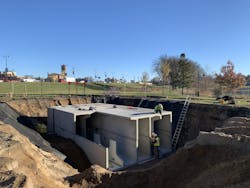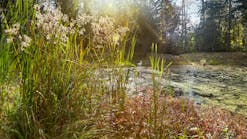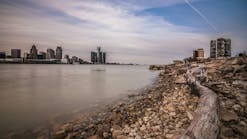Storm Water Management System Aids in Improving Lake Water Quality
StormTrap
www.stormtrap.com • 877.867.6872
Cities are pivoting to regional storm water management systems to help alleviate flooding and to treat urban runoff prior to discharge into local waterbodies. The city of St. Cloud, Minnesota, is a leader in implementing storm water best management practices, which are supported by a robust city-managed planning, inspection and maintenance program. An example of this is the Lake George Water Quality Improvement Project.
Lake George
In recent years, Lake George, a centerpiece and gathering place for many community events in St. Cloud, has experienced algae blooms that have rendered the lake green in color with unpleasant odors. Due to the high concentration of phosphorous in the water and low water clarity, the lake was included in the state’s impaired waters list.
The city took several measures to protect and improve the water quality of the lake and its 125-acre watershed through the years. In 2017, the Lake George Sub-Watershed Assessment Plan and the Water Quality Improvement Implementation Plan were completed. These plans included an in-depth look at the causes of the lake’s water quality impairment and the proposed treatment program, which comprised in-lake alum treatments and the construction of a storm water management system to treat runoff before discharging into Lake George.
Regional Treatment System
The storm water treatment system was installed in 2020 beneath an existing city parking lot in the northwest corner of Lake George. It includes a 10 feet-0 inch DoubleTrap underground basin, built with 62 modular pieces, that works as a wet detention pond and a downstream filtration system. Within the StormTrap basin, the water flows in a “U” shaped path with baffles and weirs strategically placed to settle total suspended solids and capture floatable materials. After being treated, water is slowly released into the lake. The basin’s capacity is 29,438 cubic feet of storm water and treats runoff from 60 acres that previously discharged to the lake untreated.
Initial Challenges
During the design phase, the project team faced some challenges regarding space limitations, high groundwater and poor soil conditions. The first challenge was that the area available to install the StormTrap basin under the parking lot in Eastman Park was limited.
“The layout of the system had to be strategically placed, sized and rotated to avoid impacts to the existing park trail systems and the park Veterans Memorial Monument,” said Noah Czech, storm water compliance specialist for the city of St. Cloud.
Another significant project consideration was related to the high groundwater. The system was placed adjacent to Lake George, which is the system’s receiving water. The groundwater elevation and existing storm sewer elevations dictated the available system depth and height.
“There was little available separation between groundwater and lake high water elevations and existing storm sewer elevations, making the placement of the system challenging,” Czech said.
The design team worked with StormTrap to help establish the top elevation of the system to ensure adequate coverage. The poor soil conditions were the third concern that had to be addressed in the initial phases of the project. After a geotechnical investigation, poor soil conditions were found under the east end where the system was going to be placed. The final design required subgrade improvement prior to installing the basin.
All these challenges were successfully managed by the city of St. Cloud, SEH Inc., StormTrap, and R. L. Larson Excavating Inc. through teamwork and communication.
Successful Implementation
The system currently provides storm water treatment for a 60-acre drainage area. According to the city of St. Cloud, an estimated 29.7 pounds of phosphorus and 23,600 pounds of sediment are removed annually and kept from entering the lake. The entire project was funded with a Clean Water Fund grant received in partnership with Stearns County SWCD.
With the combination of all the treatment procedures implemented in Lake George, it is expected to exceed state water quality standards and be delisted from Minnesota’s Impaired Waters list by 2022.







